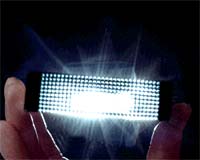 |
Palo Alto, Calif. (UPI) Aug 2, 2010 Scientists say a new process utilizing both the light and heat of solar radiation could double the efficiency of electricity-generating solar panels. Stanford University researchers say the technology, called "photon enhanced thermionic emission," could lower the costs of solar energy production to the point where it is competitive with oil as an energy source, a university release said Monday. Unlike current solar panels, which become less efficient as temperatures, panels using the PETE process excel at higher temperatures, the release said. "This is really a conceptual breakthrough, a new energy conversion process, not just a new material or a slightly different tweak," Stanford Professor Nick Melosh said. "It is actually something fundamentally different about how you can harvest energy." Such devices could be made with cheap and easily available materials, the release said. Melosh's team found that coating a piece of semiconducting material with a thin layer of the metal cesium produced a material able to use both light and heat to generate electricity. "The PETE process could really give the feasibility of solar power a big boost," Melosh said. "Even if we don't achieve perfect efficiency, let's say we give a 10 percent boost to the efficiency of solar conversion, going from 20 percent efficiency to 30 percent; that is still a 50 percent increase overall."
Share This Article With Planet Earth
Related Links All About Solar Energy at SolarDaily.com
 Solar, Infrared And Light Emitting Diode Experts Met
Solar, Infrared And Light Emitting Diode Experts MetBolingbrook IL (SPX) Jul 30, 2010 On July 12 and 13, 2010, experts from across the solar photovoltaics, infrared (IR) photovoltaics and light emitting diode (LED) disciplines met to review and discuss recent progress and future trends in the rapidly advancing fields of photonic materials and devices at the 2010 International Symposium on Optoelectronic Materials and Devices. The symposium was jointly organized by the Quant ... read more |
|
| The content herein, unless otherwise known to be public domain, are Copyright 1995-2010 - SpaceDaily. AFP and UPI Wire Stories are copyright Agence France-Presse and United Press International. ESA Portal Reports are copyright European Space Agency. All NASA sourced material is public domain. Additional copyrights may apply in whole or part to other bona fide parties. Advertising does not imply endorsement,agreement or approval of any opinions, statements or information provided by SpaceDaily on any Web page published or hosted by SpaceDaily. Privacy Statement |